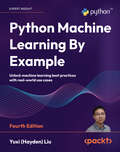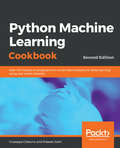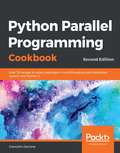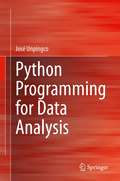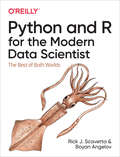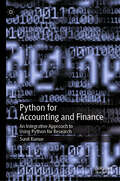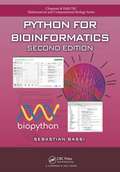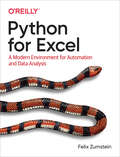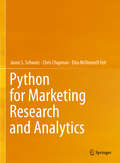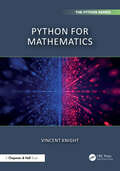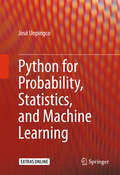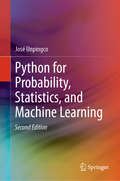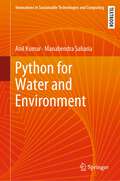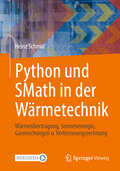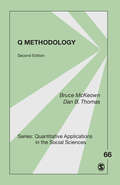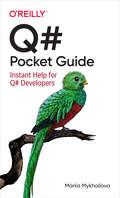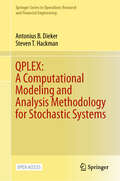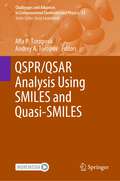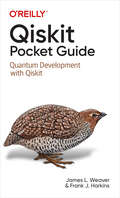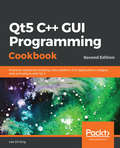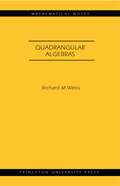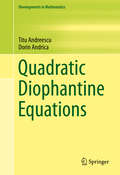- Table View
- List View
Python Machine Learning By Example: Unlock machine learning best practices with real-world use cases
by Yuxi (Hayden) LiuAuthor Yuxi (Hayden) Liu teaches machine learning from the fundamentals to building NLP transformers and multimodal models with best practice tips and real-world examples using PyTorch, TensorFlow, scikit-learn, and pandasKey FeaturesDiscover new and updated content on NLP transformers, PyTorch, and computer vision modelingIncludes a dedicated chapter on best practices and additional best practice tips throughout the book to improve your ML solutionsImplement ML models, such as neural networks and linear and logistic regression, from scratchPurchase of the print or Kindle book includes a free PDF copyBook DescriptionThe fourth edition of Python Machine Learning By Example is a comprehensive guide for beginners and experienced machine learning practitioners who want to learn more advanced techniques, such as multimodal modeling. Written by experienced machine learning author and ex-Google machine learning engineer Yuxi (Hayden) Liu, this edition emphasizes best practices, providing invaluable insights for machine learning engineers, data scientists, and analysts. Explore advanced techniques, including two new chapters on natural language processing transformers with BERT and GPT, and multimodal computer vision models with PyTorch and Hugging Face. You’ll learn key modeling techniques using practical examples, such as predicting stock prices and creating an image search engine. This hands-on machine learning book navigates through complex challenges, bridging the gap between theoretical understanding and practical application. Elevate your machine learning and deep learning expertise, tackle intricate problems, and unlock the potential of advanced techniques in machine learning with this authoritative guide.What you will learnFollow machine learning best practices throughout data preparation and model developmentBuild and improve image classifiers using convolutional neural networks (CNNs) and transfer learningDevelop and fine-tune neural networks using TensorFlow and PyTorchAnalyze sequence data and make predictions using recurrent neural networks (RNNs), transformers, and CLIPBuild classifiers using support vector machines (SVMs) and boost performance with PCAAvoid overfitting using regularization, feature selection, and moreWho this book is forThis expanded fourth edition is ideal for data scientists, ML engineers, analysts, and students with Python programming knowledge. The real-world examples, best practices, and code prepare anyone undertaking their first serious ML project.
Python Machine Learning Cookbook: Over 100 recipes to progress from smart data analytics to deep learning using real-world datasets, 2nd Edition
by Prateek Joshi Giuseppe CiaburroDiscover powerful ways to effectively solve real-world machine learning problems using key libraries including scikit-learn, TensorFlow, and PyTorch Key Features Learn and implement machine learning algorithms in a variety of real-life scenarios Cover a range of tasks catering to supervised, unsupervised and reinforcement learning techniques Find easy-to-follow code solutions for tackling common and not-so-common challenges Book Description This eagerly anticipated second edition of the popular Python Machine Learning Cookbook will enable you to adopt a fresh approach to dealing with real-world machine learning and deep learning tasks. With the help of over 100 recipes, you will learn to build powerful machine learning applications using modern libraries from the Python ecosystem. The book will also guide you on how to implement various machine learning algorithms for classification, clustering, and recommendation engines, using a recipe-based approach. With emphasis on practical solutions, dedicated sections in the book will help you to apply supervised and unsupervised learning techniques to real-world problems. Toward the concluding chapters, you will get to grips with recipes that teach you advanced techniques including reinforcement learning, deep neural networks, and automated machine learning. By the end of this book, you will be equipped with the skills you need to apply machine learning techniques and leverage the full capabilities of the Python ecosystem through real-world examples. What you will learn Use predictive modeling and apply it to real-world problems Explore data visualization techniques to interact with your data Learn how to build a recommendation engine Understand how to interact with text data and build models to analyze it Work with speech data and recognize spoken words using Hidden Markov Models Get well versed with reinforcement learning, automated ML, and transfer learning Work with image data and build systems for image recognition and biometric face recognition Use deep neural networks to build an optical character recognition system Who this book is for This book is for data scientists, machine learning developers, deep learning enthusiasts and Python programmers who want to solve real-world challenges using machine-learning techniques and algorithms. If you are facing challenges at work and want ready-to-use code solutions to cover key tasks in machine learning and the deep learning domain, then this book is what you need. Familiarity with Python programming and machine learning concepts will be useful.
Python Parallel Programming Cookbook: Over 70 recipes to solve challenges in multithreading and distributed system with Python 3, 2nd Edition
by Giancarlo ZacconeImplement effective programming techniques in Python to build scalable software that saves time and memory Key Features Design distributed computing systems and massive computational tasks coherently Learn practical recipes with concise explanations that address development pain points encountered while coding parallel programs Understand how to host your parallelized applications on the cloud Book Description Nowadays, it has become extremely important for programmers to understand the link between the software and the parallel nature of their hardware so that their programs run efficiently on computer architectures. Applications based on parallel programming are fast, robust, and easily scalable. This updated edition features cutting-edge techniques for building effective concurrent applications in Python 3.7. The book introduces parallel programming architectures and covers the fundamental recipes for thread-based and process-based parallelism. You'll learn about mutex, semaphores, locks, queues exploiting the threading, and multiprocessing modules, all of which are basic tools to build parallel applications. Recipes on MPI programming will help you to synchronize processes using the fundamental message passing techniques with mpi4py. Furthermore, you'll get to grips with asynchronous programming and how to use the power of the GPU with PyCUDA and PyOpenCL frameworks. Finally, you'll explore how to design distributed computing systems with Celery and architect Python apps on the cloud using PythonAnywhere, Docker, and serverless applications. By the end of this book, you will be confident in building concurrent and high-performing applications in Python. What you will learn Synchronize multiple threads and processes to manage parallel tasks Use message passing techniques to establish communication between processes to build parallel applications Program your own GPU cards to address complex problems Manage computing entities to execute distributed computational task Write efficient programs by adopting the event-driven programming model Explore cloud technology with Django and Google App Engine Apply parallel programming techniques that can lead to performance improvements Who this book is for The Python Parallel Programming Cookbook is for software developers who are well-versed with Python and want to use parallel programming techniques to write powerful and efficient code. This book will help you master the basics and the advanced of parallel computing.
Python Programming for Data Analysis
by José UnpingcoThis textbook grew out of notes for the ECE143 Programming for Data Analysis class that the author has been teaching at University of California, San Diego, which is a requirement for both graduate and undergraduate degrees in Machine Learning and Data Science. This book is ideal for readers with some Python programming experience. The book covers key language concepts that must be understood to program effectively, especially for data analysis applications. Certain low-level language features are discussed in detail, especially Python memory management and data structures. Using Python effectively means taking advantage of its vast ecosystem. The book discusses Python package management and how to use third-party modules as well as how to structure your own Python modules. The section on object-oriented programming explains features of the language that facilitate common programming patterns.After developing the key Python language features, the book moves on to third-party modules that are foundational for effective data analysis, starting with Numpy. The book develops key Numpy concepts and discusses internal Numpy array data structures and memory usage. Then, the author moves onto Pandas and details its many features for data processing and alignment. Because strong visualizations are important for communicating data analysis, key modules such as Matplotlib are developed in detail, along with web-based options such as Bokeh, Holoviews, Altair, and Plotly.The text is sprinkled with many tricks-of-the-trade that help avoid common pitfalls. The author explains the internal logic embodied in the Python language so that readers can get into the Python mindset and make better design choices in their codes, which is especially helpful for newcomers to both Python and data analysis. To get the most out of this book, open a Python interpreter and type along with the many code samples.
Python and R for the Modern Data Scientist
by Rick J. Scavetta Boyan AngelovSuccess in data science depends on the flexible and appropriate use of tools. That includes Python and R, two of the foundational programming languages in the field. This book guides data scientists from the Python and R communities along the path to becoming bilingual. By recognizing the strengths of both languages, you'll discover new ways to accomplish data science tasks and expand your skill set.Authors Rick Scavetta and Boyan Angelov explain the parallel structures of these languages and highlight where each one excels, whether it's their linguistic features or the powers of their open source ecosystems. You'll learn how to use Python and R together in real-world settings and broaden your job opportunities as a bilingual data scientist.Learn Python and R from the perspective of your current languageUnderstand the strengths and weaknesses of each languageIdentify use cases where one language is better suited than the otherUnderstand the modern open source ecosystem available for both, including packages, frameworks, and workflowsLearn how to integrate R and Python in a single workflowFollow a case study that demonstrates ways to use these languages together
Python for Accounting and Finance: An Integrative Approach to Using Python for Research
by Sunil KumarThis book is a comprehensive guide to the application of Python in accounting, finance, and other business disciplines. This book is more than a Python tutorial; it is an integrative approach to using Python for practical research in these fields. The book begins with an introduction to Python and its key libraries. It then covers real-world applications of Python, covering data acquisition, cleaning, exploratory data analysis, visualization, and advanced topics like natural language processing, machine learning, predictive analytics, and deep learning. What sets this book apart is its unique blend of theoretical knowledge and real-world examples, supplemented with ready-to-use code. It doesn't stop at the syntax; it shows how to apply Python to tackle actual analytical problems. The book uses case studies to illustrate how Python can enhance traditional research methods in accounting and finance, not only allowing the reader to gain a firm understanding of Pythonprogramming but also equipping them with the skills to apply Python to accounting, finance, and broader business research. Whether you are a PhD student, a professor, an industry professional, or a financial researcher, this book provides the key to unlocking the full potential of Python in research.
Python for Bioinformatics (Chapman & Hall/CRC Mathematical and Computational Biology)
by Sebastian BassiIn today's data driven biology, programming knowledge is essential in turning ideas into testable hypothesis. Based on the author’s extensive experience, Python for Bioinformatics, Second Edition helps biologists get to grips with the basics of software development. Requiring no prior knowledge of programming-related concepts, the book focuses on the easy-to-use, yet powerful, Python computer language. This new edition is updated throughout to Python 3 and is designed not just to help scientists master the basics, but to do more in less time and in a reproducible way. New developments added in this edition include NoSQL databases, the Anaconda Python distribution, graphical libraries like Bokeh, and the use of Github for collaborative development.
Python for Excel: A Modern Environment For Automation And Data Analysis
by Felix ZumsteinWhile Excel remains ubiquitous in the business world, recent Microsoft feedback forums are full of requests to include Python as an Excel scripting language. In fact, it's the top feature requested. What makes this combination so compelling? In this hands-on guide, Felix Zumstein--creator of xlwings, a popular open source package for automating Excel with Python--shows experienced Excel users how to integrate these two worlds efficiently.Excel has added quite a few new capabilities over the past couple of years, but its automation language, VBA, stopped evolving a long time ago. Many Excel power users have already adopted Python for daily automation tasks. This guide gets you started.Use Python without extensive programming knowledgeGet started with modern tools, including Jupyter notebooks and Visual Studio codeUse pandas to acquire, clean, and analyze data and replace typical Excel calculationsAutomate tedious tasks like consolidation of Excel workbooks and production of Excel reportsUse xlwings to build interactive Excel tools that use Python as a calculation engineConnect Excel to databases and CSV files and fetch data from the internet using Python codeUse Python as a single tool to replace VBA, Power Query, and Power Pivot
Python for Marketing Research and Analytics
by Chris Chapman Elea McDonnell Feit Jason S. SchwarzThis book provides an introduction to quantitative marketing with Python. The book presents a hands-on approach to using Python for real marketing questions, organized by key topic areas. Following the Python scientific computing movement toward reproducible research, the book presents all analyses in Colab notebooks, which integrate code, figures, tables, and annotation in a single file. The code notebooks for each chapter may be copied, adapted, and reused in one's own analyses. The book also introduces the usage of machine learning predictive models using the Python sklearn package in the context of marketing research. This book is designed for three groups of readers: experienced marketing researchers who wish to learn to program in Python, coming from tools and languages such as R, SAS, or SPSS; analysts or students who already program in Python and wish to learn about marketing applications; and undergraduate or graduate marketing students with little or no programming background. It presumes only an introductory level of familiarity with formal statistics and contains a minimum of mathematics.
Python for Mathematics (Chapman & Hall/CRC The Python Series)
by Vincent KnightPython for Mathematics introduces readers to effective methods for doing mathematics using the Python programming language. Most programming texts introduce readers to the building blocks of programming and build up to using more sophisticated tools for a specific purpose, like doing particular mathematical tasks. This is akin to teaching someone how to forge metal so as to make a nail, and then slowly working up to using sophisticated power tools so as to actually build something. This book does things in a different way, by first getting readers to begin using and understanding the tools that are going to be helpful to them as mathematicians, and only then moving onto the granular details. In this way, the practical application of the tools can aid in the understanding of the theory.Features· Complete with engaging, practical exercises· Many useful and detailed coding examples· Suitable for undergraduates in mathematics, and other quantitative sciences· Empowers readers to design and create their own Python tools.
Python for Probability, Statistics, and Machine Learning
by José UnpingcoThis book covers thekey ideas that link probability, statistics, and machine learning illustratedusing Python modules in these areas. The entire text, including all thefigures and numerical results, is reproducible using the Python codes and theirassociated Jupyter/IPython notebooks, which are provided as supplementarydownloads. The author develops key intuitions in machine learning by workingmeaningful examples using multiple analytical methods and Python codes, therebyconnecting theoretical concepts to concrete implementations. Modern Pythonmodules like Pandas, Sympy, and Scikit-learn are applied to simulate andvisualize important machine learning concepts like the bias/variance trade-off,cross-validation, and regularization. Many abstract mathematical ideas, such asconvergence in probability theory, are developed and illustrated with numericalexamples. This book is suitable for anyone with an undergraduate-levelexposure to probability, statistics, or machine learning and with rudimentaryknowledge of Python programming.
Python for Probability, Statistics, and Machine Learning
by José UnpingcoThis textbook, fully updated to feature Python version 3.7, covers the key ideas that link probability, statistics, and machine learning illustrated using Python modules. The entire text, including all the figures and numerical results, is reproducible using the Python codes and their associated Jupyter/IPython notebooks, which are provided as supplementary downloads. The author develops key intuitions in machine learning by working meaningful examples using multiple analytical methods and Python codes, thereby connecting theoretical concepts to concrete implementations. The update features full coverage of Web-based scientific visualization with Bokeh Jupyter Hub; Fisher Exact, Cohen’s D and Rank-Sum Tests; Local Regression, Spline, and Additive Methods; and Survival Analysis, Stochastic Gradient Trees, and Neural Networks and Deep Learning. Modern Python modules like Pandas, Sympy, and Scikit-learn are applied to simulate and visualize important machine learning concepts like the bias/variance trade-off, cross-validation, and regularization. Many abstract mathematical ideas, such as convergence in probability theory, are developed and illustrated with numerical examples. This book is suitable for classes in probability, statistics, or machine learning and requires only rudimentary knowledge of Python programming.
Python for Probability, Statistics, and Machine Learning
by José UnpingcoThis book, fully updated for Python version 3.6+, covers the key ideas that link probability, statistics, and machine learning illustrated using Python modules in these areas. All the figures and numerical results are reproducible using the Python codes provided. The author develops key intuitions in machine learning by working meaningful examples using multiple analytical methods and Python codes, thereby connecting theoretical concepts to concrete implementations. Detailed proofs for certain important results are also provided. Modern Python modules like Pandas, Sympy, Scikit-learn, Tensorflow, and Keras are applied to simulate and visualize important machine learning concepts like the bias/variance trade-off, cross-validation, and regularization. Many abstract mathematical ideas, such as convergence in probability theory, are developed and illustrated with numerical examples. This updated edition now includes the Fisher Exact Test and the Mann-Whitney-Wilcoxon Test. A new section on survival analysis has been included as well as substantial development of Generalized Linear Models. The new deep learning section for image processing includes an in-depth discussion of gradient descent methods that underpin all deep learning algorithms. As with the prior edition, there are new and updated *Programming Tips* that the illustrate effective Python modules and methods for scientific programming and machine learning. There are 445 run-able code blocks with corresponding outputs that have been tested for accuracy. Over 158 graphical visualizations (almost all generated using Python) illustrate the concepts that are developed both in code and in mathematics. We also discuss and use key Python modules such as Numpy, Scikit-learn, Sympy, Scipy, Lifelines, CvxPy, Theano, Matplotlib, Pandas, Tensorflow, Statsmodels, and Keras.This book is suitable for anyone with an undergraduate-level exposure to probability, statistics, or machine learning and with rudimentary knowledge of Python programming.
Python for Water and Environment (Innovations in Sustainable Technologies and Computing)
by Anil Kumar Manabendra SahariaThis textbook delves into the practical applications of surface and groundwater hydrology, as well as the environment. The Part I, "Practical Python for a Water and Environment Professional," guides readers through setting up a scientific computing environment and conducting exploratory data analysis and visualization using reproducible workflows. The Part II, "Statistical Modeling in Hydrology," covers regression models, time series analysis, and common hypothesis testing. The Part III, "Surface and Subsurface Water," illustrates the use of Python in understanding key concepts related to seepage, groundwater, and surface water flows. Lastly, the Part IV, "Environmental Applications," demonstrates the application of Python in the study of various contaminant transport phenomena.
Python und SMath in der Wärmetechnik: Wärmeübertragung, Sonnenenergie, Gasmischungen u. Verbrennungsrechnung
by Heinz SchmidDieses Buch verbindet Ingenieurstheorie, Thermodynamik und Wärmeübertragung mit Softwareanwendungen wie SMath, MathCAD und Python. Es ist kein klassisches Lehrbuch, behandelt jedoch die grundlegenden Gleichungen und kommentiert Python-Programme. Zudem wird die Entwicklung von Wärmeaustauscher-Programmen mit Python-GUIs thematisiert, unter Nutzung leistungsstarker Bibliotheken. Querverweise zu aktuellen globalen Problemen wie dem Klimawandel und Lösungen, z.B. die Nutzung von grünem Wasserstoff, werden ebenfalls aufgezeigt.
Q Methodology
by Bruce F. Mckeown Dan B. ThomasDirect, well-organized, and easy to follow, Q Methodology, Second Edition, by Bruce McKeown and Dan B. Thomas, reviews the philosophical foundations of subjective communicability (concourse theory), operant subjectivity, and quantum-theoretical aspects of Q as relevant to the social and behavioral sciences. The authors discuss data-gathering techniques (communication concourses, Q samples, and Q sorting), statistical techniques (correlation and factor analysis and the important calculation of factor scores), and strategies for conducting small person-sample research along Q methodological lines.
Q# Pocket Guide: Instant Help for Q# Developers
by Mariia MykhailovaReady to build quantum computing applications using Q# and the Microsoft Quantum Development Kit? This is the book for you. Q# is a domain-specific language for expressing quantum algorithms that combines familiar "classical" language constructs with quantum-specific ones. Ideal for any developer familiar with (or willing to learn) the basics of quantum computing and looking to get started with quantum programming, this pocket guide quickly helps you find syntax and usage information for unfamiliar aspects of Q#.You'll explore the quantum software development lifecycle from implementing the program to running it on quantum simulators to testing and debugging it. You'll learn to use the tools provided by Microsoft's Quantum Development Kit for each step of the process.You'll explore:Q# language details, including data types, statements, and operatorsGuidelines for organizing Q# code and invoking it from different environmentsInformation on simulators and tools in the Microsoft Quantum Development KitAdvice on testing and debugging tools and techniques for quantum programs
QCA with R: A Comprehensive Resource
by Adrian DuşaThis book is a comprehensive guide to qualitative comparative analysis (QCA) using R. Using Boolean algebra to implement principles of comparison used by scholars engaged in the qualitative study of macro social phenomena, QCA acts as a bridge between the quantitative and the qualitative traditions. The QCA package for R, created by the author, facilitates QCA within a graphical user interface. This book provides the most current information on the latest version of the QCA package, which combines written commands with a cross-platform interface. Beginning with a brief introduction to the concept of QCA, this book moves from theory to calibration, from analysis to factorization, and hits on all the key areas of QCA in between. Chapters one through three are introductory, familiarizing the reader with R, the QCA package, and elementary set theory. The next few chapters introduce important applications of the package beginning with calibration, analysis of necessity, analysis of sufficiency, parameters of fit, negation and factorization, and the construction of Venn diagrams. The book concludes with extensions to the classical package, including temporal applications and panel data. Providing a practical introduction to an increasingly important research tool for the social sciences, this book will be indispensable for students, scholars, and practitioners interested in conducting qualitative research in political science, sociology, business and management, and evaluation studies. <P><P><i>Advisory: Bookshare has learned that this book offers only partial accessibility. We have kept it in the collection because it is useful for some of our members. Benetech is actively working on projects to improve accessibility issues such as these.</i>
QPLEX: A Computational Modeling and Analysis Methodology for Stochastic Systems (Springer Series in Operations Research and Financial Engineering)
by Steven T. Hackman Antonius B. DiekerThis book introduces QPLEX, a powerful computational framework designed for modeling and analyzing nonstationary stochastic systems with large state spaces. The methodology excels at rapidly and accurately generating approximate distributions of system performance over time, offering a robust tool for understanding the dynamics of such systems. QPLEX circumvents the curse of dimensionality by imposing conditional independence, which may be represented via a probabilistic graphical model, and exploiting model dynamics. It is specifically crafted for transient analysis of nonstationary systems, often encountered in practical applications but rarely addressed by traditional techniques. It can work directly with empirical distributions and requires no stability assumptions. Since its output is not noisy, QPLEX is tailor-made for sensitivity analysis and optimization. The methodology’s few model primitives are flexible enough to specify a rich array of models. For example, models representing queueing networks can exhibit challenging characteristics such as short operational horizons; time-varying arrival rates, service durations, and numbers of servers; and complex routing of entities. The text is accessible to those with engineering, computer science, or mathematics backgrounds and knowledge of probability and stochastic models at the advanced undergraduate level. Many fully worked-out examples aid the comprehension of the concepts and calculations, ensuring readers can effectively apply the methods to real-world systems and making this book a valuable resource for researchers and practitioners alike. This is an open access book.
QSPR/QSAR Analysis Using SMILES and Quasi-SMILES (Challenges and Advances in Computational Chemistry and Physics #33)
by Alla P. Toropova Andrey A. ToropovThis contributed volume overviews recently presented approaches for carrying out QSPR/QSAR analysis by using a simplifying molecular input-line entry system (SMILES) to represent the molecular structure. In contrast to traditional SMILES, quasi-SMILES is a sequence of special symbols-codes that reflect molecular features and codes of experimental conditions. SMILES and quasi-SMILES serve as a basis to develop QSPR/QSAR as well Nano-QSPR/QSAR via the Monte Carlo calculation that provides the so-called optimal descriptors for QSPR/QSAR models. The book presents a reliable technology for developing Nano-QSPR/QSAR while it also includes the description of the algorithms of the Monte Carlo optimization. It discusses the theory and practice of the technique of variational authodecoders (VAEs) based on SMILES and analyses in detail the index of ideality of correlation (IIC) and the correlation intensity index (CII) which are new criteria for the predictive potential of the model. The mathematical apparatus used is simple so that students of relevant specializations can easily follow. This volume is a valuable contribution to the field and will be of great interest to developers of models of physicochemical properties and biological activity, chemical technologists, and toxicologists involved in the area of drug design.
Qiskit Pocket Guide: Quantum Development with Qiskit
by James L. Weaver Frank J. HarkinsThe quantum computing market is predicted to grow by nearly $1.3 billion over the next five years. Why? Given their quantum mechanical nature, quantum computers are expected to solve difficult problems in chemistry, optimization, finance, and machine learning that classical computers find impossible to unravel.This pocket guide provides software developers with a quick reference to Qiskit, an open source SDK for working with quantum computers. Packed with helpful programming examples, tables, figures, and lists, this handy book helps you find the information you need to develop and debug quantum programs.Whether you're focused on business, engineering, or scientific applications, you'll learn how to choose and apply appropriate Qiskit classes, methods, and functions.Learn how to create quantum circuits, define quantum gates, and leverage the transpilerExplore modules for implementing quantum information concepts and quantum algorithmsSurvey features of Qiskit that abstract and facilitate working with various quantum computers and simulatorsLearn how to use the latest version of the Open Quantum Assembly Language
Qt5 C++ GUI Programming Cookbook: Practical recipes for building cross-platform GUI applications, widgets, and animations with Qt 5
by Lee Zhi Eng<p>Use Qt 5 to design and build functional, appealing, and user-friendly graphical user interfaces (GUIs) for your applications. <p>Key Features: <p> <li>Learn to use Qt 5 to design and customize the look and feel of your application <li>Improve the visual quality of an application by using graphics rendering and animation <li>Understand the balance of presentation and web content that will make an application appealing yet functional</li> <p> <p>Book Description: <p>With the growing need to develop GUIs for multiple targets and multiple screens, improving the visual quality of your application becomes important so that it stands out from your competitors. With its cross-platform ability and the latest UI paradigms, Qt makes it possible to build intuitive, interactive, and user-friendly user interfaces for your applications. <p>Qt5 C++ GUI Programming Cookbook, Second Edition teaches you how to develop functional and appealing user interfaces using the latest version of QT5 and C++.This book will help you learn a variety of topics such as GUI customization and animation, graphics rendering, implementing Google Maps, and more. You will also be taken through advanced concepts like asynchronous programming, event handling using signals and slots, network programming, various aspects of optimizing your application. <p>By the end of the book, you will be confident to design and customize GUI applications that meet your clients' expectations and have an understanding of best practice solutions for common problems. <p>What you will learn: <p> <li>Animate GUI elements using Qt5's built-in animation system <li>Draw shapes and 2D images using Qt5's powerful rendering system <li>Implement an industry-standard OpenGL library in your project <li>Build a mobile app that supports touch events and exports it onto devices <li>Parse and extract data from an XML file and present it on your GUI <li>Interact with web content by calling JavaScript functions from C++ <li>Access MySQL and SQLite databases to retrieve data and display it on your GUI</li> <p> <p>Who this book is for: This intermediate-level book is designed for those who want to develop software using Qt 5. If you want to improve the visual quality and content presentation of your software application, this book is for you. Prior experience of C++ programming is required.</p>
Quadrangular Algebras. (Mathematical Notes #46)
by Richard M. WeissThis book introduces a new class of non-associative algebras related to certain exceptional algebraic groups and their associated buildings. Richard Weiss develops a theory of these "quadrangular algebras" that opens the first purely algebraic approach to the exceptional Moufang quadrangles. These quadrangles include both those that arise as the spherical buildings associated to groups of type E6, E7, and E8 as well as the exotic quadrangles "of type F4" discovered earlier by Weiss. Based on their relationship to exceptional algebraic groups, quadrangular algebras belong in a series together with alternative and Jordan division algebras. Formally, the notion of a quadrangular algebra is derived from the notion of a pseudo-quadratic space (introduced by Jacques Tits in the study of classical groups) over a quaternion division ring. This book contains the complete classification of quadrangular algebras starting from first principles. It also shows how this classification can be made to yield the classification of exceptional Moufang quadrangles as a consequence. The book closes with a chapter on isotopes and the structure group of a quadrangular algebra. Quadrangular Algebras is intended for graduate students of mathematics as well as specialists in buildings, exceptional algebraic groups, and related algebraic structures including Jordan algebras and the algebraic theory of quadratic forms.
Quadratic Diophantine Equations
by Titu Andreescu Dorin AndricaThis text treats the classical theory of quadratic diophantine equations and guides the reader through the last two decades of computational techniques and progress in the area. The presentation features two basic methods to investigate and motivate the study of quadratic diophantine equations: the theories of continued fractions and quadratic fields. It also discusses Pell's equation and its generalizations, and presents some important quadratic diophantine equations and applications. The inclusion of examples makes this book useful for both research and classroom settings.
